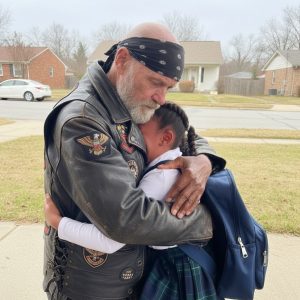Paragraph 1:
The memory begins with something simple and domestic: a plastic container filled with Thanksgiving food, but for the narrator, it becomes a moment of revelation. Only when the container is opened in the privacy of the kitchen does its significance fully settle in—turkey, stuffing, mashed potatoes, and gravy, each item carefully portioned and still warm. The warmth at the center contrasts with the cold reality the narrator and their mother had grown familiar with, a reality marked by scarcity and unspoken hunger. This small, unexpected offering forces an acknowledgment neither of them is prepared for: someone outside their home has noticed their quiet struggle. The carefully packed meal is more than food; it is evidence of an invisible watcher, someone attentive to their hardship, someone who cared enough to intervene.
Paragraph 2:
The mother’s reaction reveals the emotional weight of being seen in a moment of vulnerability. Her face crumples—not out of shame or self-pity, but from a painful blend of gratitude, surprise, and protective sorrow. The narrator understands immediately that the gesture carries implications beyond charity. It means their attempts to hide hunger have failed; it means their mother’s efforts to stretch small amounts of food have been visible to others. The narrator has been pretending not to be hungry, and the mother has been trying to shield the child from the full extent of their situation. In the mother’s expression, the narrator recognizes both the humiliation of exposure and the relief that someone has offered help without being asked. The moment is heavy, but it is also transforming: acknowledgment from the outside world makes their hardship real in a different way.
Paragraph 3:
That Thanksgiving becomes a turning point in the narrator’s understanding of what care can look like. They learn that care does not always come dressed in the gentle language society associates with kindness. Sometimes compassion shows up ungracefully, in gestures that cause embarrassment before bringing comfort. The experience challenges the narrator’s assumptions about what love should feel like; love can be awkward, clumsy, or even abrasive. It can come from someone who doesn’t know how to express softness, someone whose concern might sound like judgment or pity even when rooted in genuine goodwill. This newfound understanding complicates the narrator’s relationship to care, making it clear that the emotional tone of a gesture does not always align with its intention or value.
Paragraph 4:
As the narrator grows older, this lesson evolves into a broader insight about people and their emotional textures. Encounters with individuals who are blunt, curt, or difficult to read are no longer taken at face value. Instead, the narrator builds in a margin of empathy, a recognition that rough edges may conceal tender motives. They have learned not to assume that hardness is the opposite of compassion; often, it is merely a different dialect of concern. The memory of that Thanksgiving meal shapes how they navigate social interactions, teaching them to search beneath surface behavior for the complicated, sometimes mismatched intentions that drive human connection. The narrator understands, perhaps earlier than most, that compassion often wears imperfect disguises.
Paragraph 5:
The narrator also acknowledges the personal impact of receiving help as a child. That one act—someone quietly noticing, quietly providing—has stayed with them, guiding how they give care to others. Now an adult, the narrator responds to the memory not by clinging to the embarrassment of the moment but by embracing the kindness that motivated it. The emotional complexity of that day becomes a template for how to treat others who might be struggling silently. The narrator is driven by the desire to interrupt someone else’s unspoken hunger, just as their own was once interrupted. This impulse is not about charity or pity; it is about offering dignity, recognition, and relief without demanding the vulnerable person expose their need.
Paragraph 6:
Each Thanksgiving, the narrator continues the cycle of compassion by packing an extra plate of food—an act of quiet, intentional generosity. It is not a grand gesture or a public one; it echoes the same spirit of the container they once received, the kind that whispers rather than announces. Through this ritual, the narrator hopes to offer another child the message they themselves needed: you are not a burden. This yearly act becomes a way of honoring the complicated, awkward forms of love that shaped their childhood. It reflects the narrator’s belief that even imperfect expressions of care can change the course of someone’s life. The tradition stands as a testament to the power of small kindnesses and the way they ripple through time, turning a moment of vulnerability into a source of ongoing compassion for others.




